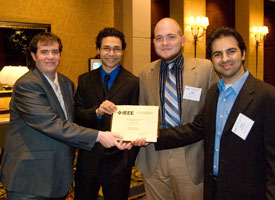A few sleepless nights and some creative thinking paid off big for one University of Houston robotics team at the 2010 Institute of Electrical and Electronics Engineers (IEEE) Region 5 Technical, Professional and Student Conference Saturday.
The team—led by electrical engineering senior Osaid Shamsi, and comprised of electrical engineering seniors Carlos Moran, James Beamer and computer engineering senior John Hemmick—beat out more than 26 teams from 10 states to capture first in the event.
Hosted by IEEE, the nation’s largest electrical engineering professional organization, it was the second time in two years UH has taken the top spot for the region. In 2009, a group of students made history when they became the first UH team, ever, to win it.
“There are so many good teams with very clever designs for their robots,” said John Glover, electrical and computer engineering professor and the robotics teams' advisor. “Each year it comes down to a handful who are the favorites—the ones that all the other teams are watching. We are frequently among those few, and the last two years we've been fortunate enough to come out on top. Both of our teams this year had good designs, and both had a chance of winning. I'm hoping these wins will encourage next year's teams to continue the tradition of highly-competitive-robots from UH.”
At the Dallas competition, two UH teams were pitted against groups from Texas, Louisiana, Missouri, Colorado, Arkansas, South Dakota, Kansas, Oklahoma, New Mexico and Wyoming.
The autonomous robots competed on a square track equipped with an LED light in each of the track’s four corners. Each of these lights emitted frequencies representing the resistance value of one of four eight-inch copper containers placed in the middle of the track.
At the start of each run, judges randomly set the resistance frequencies in each of the corners. Robots were programmed to measure the resistance values of the containers and take them to the corresponding corner. Though time was a factor—participants had a four-minute time limit—the run was based on the number of points you earned for successful deliveries of the containers.
Both UH teams made it through the qualifying round, and went on to compete against 10 other teams in the first round of finals. Here, teams had to complete the same task while maneuvering around randomly placed wind turbines.
Most of the robots were programmed to use the black lines on the track to guide them to the proper corners, but the turbines—randomly placed the day of competition—still proved tricky for many. This included UH’s second team—consisting of computer engineering senior Gary Reyes and electrical engineering seniors, Daniel Mora, Luan Vo and Colin Nankervis.
But the winning UH team was able to overcome the obstacles due to some ingenious design utilizing those lines.
“We kept our robot small—only six-inches-by-six-inches,” said Shamsi. “Most designed to the maximum allowable size. Our algorithms and the original design allowed us to keep close to the black lines. Six inches from the black lines, they couldn’t put a windmill.”
Though they only delivered two containers, they still came out with the highest score—500.
The win was the result of months of missed sleep as team members worked tirelessly on the robots—their big project for senior design. Team members estimated putting a few thousand hours into the design of their robots from the time they began conceptualizing in the last few days of December 2009 up until the April 17 competition.
Aside from long hours and many unforeseen challenges they were tasked to solve, members from both teams said it was all worth it.
“We learned not to give up,” said Vo.
For John Hemmick, what the teams accomplished is something other engineering students can be proud of, and, maybe even serve as a legacy others will be encouraged to continue.
